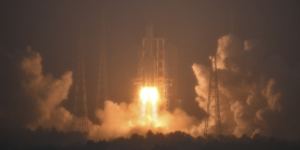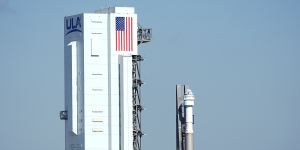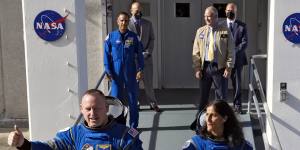The landing elevates China’s space power status in a global rush to the moon,where countries including the United States are hoping to exploit lunar minerals to sustain long-term astronaut missions and moon bases within the next decade.

A rocket carrying the Chang’e-6 spacecraft launches in China last month.Xinhua
The Chang’e-6 craft,equipped with an array of tools and its own launcher,touched down in a gigantic impact crater called the South Pole-Aitken Basin on the moon’s space-facing side at 8.23am (AEST),the China National Space Administration said.
The successful mission is China’s second on the far side of the moon,a region no other country has reached. The side of the moon perpetually facing away from the Earth is dotted with deep and dark craters,making communications and robotic landing operations more challenging.
Using a scoop and drill,the Chang’e-6 lander will aim to collect two kilograms of lunar material over two days and bring it back to Earth.
The samples will be transferred to a rocket booster atop the lander,which will launch back into space,tag up with another spacecraft in lunar orbit and return,landing in China’s Inner Mongolia region about June 25.
If all goes as planned,the mission will provide China with a pristine record of the moon’s 4.5 billion-year history and yield new clues on the solar system’s formation. It will also allow for an unprecedented comparison between the dark,unexplored region with the moon’s better understood Earth-facing side.
American launch stalls
The success came less than 12 hours after a second attempt at launching Boeing’s new Starliner space capsule,on its inaugural test flight with NASA astronauts on board,was aborted with minutes to go by a computer-abort system,mission officials said.
The gumdrop-shaped Starliner capsule had stood ready for blast-off from NASA’s Kennedy Space Centre in Florida,perched atop the Atlas V.
But with three minutes and 50 seconds left in the countdown clock after the final “go” for launch was given by the flight director,a ground system computer triggered an automatic abort command that shut down the launch sequence,according to mission officials.

Boeing’s Starliner capsule,pictured atop an Atlas V rocket,will remain on earth for now.AP
The scrubbed launch,capping a string of 11th-hour technical issues that ground teams worked through and resolved earlier in the countdown,adds another indefinite delay for the highly anticipated and much-delayed test flight.
The next available launch window for the mission was on Sunday,but NASA said mission officials would forgo that opportunity,without setting a new date. The next available chances to launch are Wednesday,June 5,and Thursday,June 6.
“We got really close today,” said Steve Stich,manager of NASA’s commercial crew program. “I know it’s a little disappointing,we were all excited. This is kind of the way spaceflight is.”
The CST-200 Starliner’s first crewed voyage to the International Space Station (ISS),with two astronauts aboard,remains a key milestone for Boeing as it scrambles to gain a greater share of lucrative NASA business now dominated by Elon Musk’s SpaceX.
ULA Chief Executive Tory Bruno said the leading causes would be “either a hardware problem or a network communication” issue between three computers that control automated launch systems.
Boeing's Starliner test flight has been called off just 3 minutes and 50 seconds before liftoff due to computer problems.
The first attempt by Boeing to send an uncrewed Starliner to the space station in 2019 failed due to software and engineering glitches. A second try in 2022 succeeded,paving the way for efforts at getting the first crewed test mission off the ground.
A May 6 countdown was halted just two hours before launch time over a faulty pressure valve on the Atlas V upper stage,followed by weeks of further delays caused by other engineering problems,since resolved,on the Starliner itself.
It is not uncommon in the space industry for countdowns to be halted at the 11th hour and for launches to be postponed for days or weeks,even when seemingly minor malfunctions or unusual sensor readings are detected,especially in new spacecraft carrying humans for the first time.

NASA astronauts Butch Wilmore (left) and Suni Williams.AP
Boeing,whose commercial airplane manufacturing operations are in disarray after several crises,badly needs a success in space for its Starliner venture,a program several years behind schedule with more than $US1.5 billion ($2.25 billion) in cost overruns.
While Boeing has struggled,SpaceX has developed into a dependable space taxi service for NASA,providing the only means of launching the ISS crew to orbit from US soil.
NASA,backing a new generation of privately built spacecraft,sees Starliner as an important second vehicle capable of ferrying astronauts to and from the space station,as well as the moon and eventually Mars under its ambitious Artemis program.
Reuters
Get a note directly from our foreign correspondents on what’s making headlines around the world..